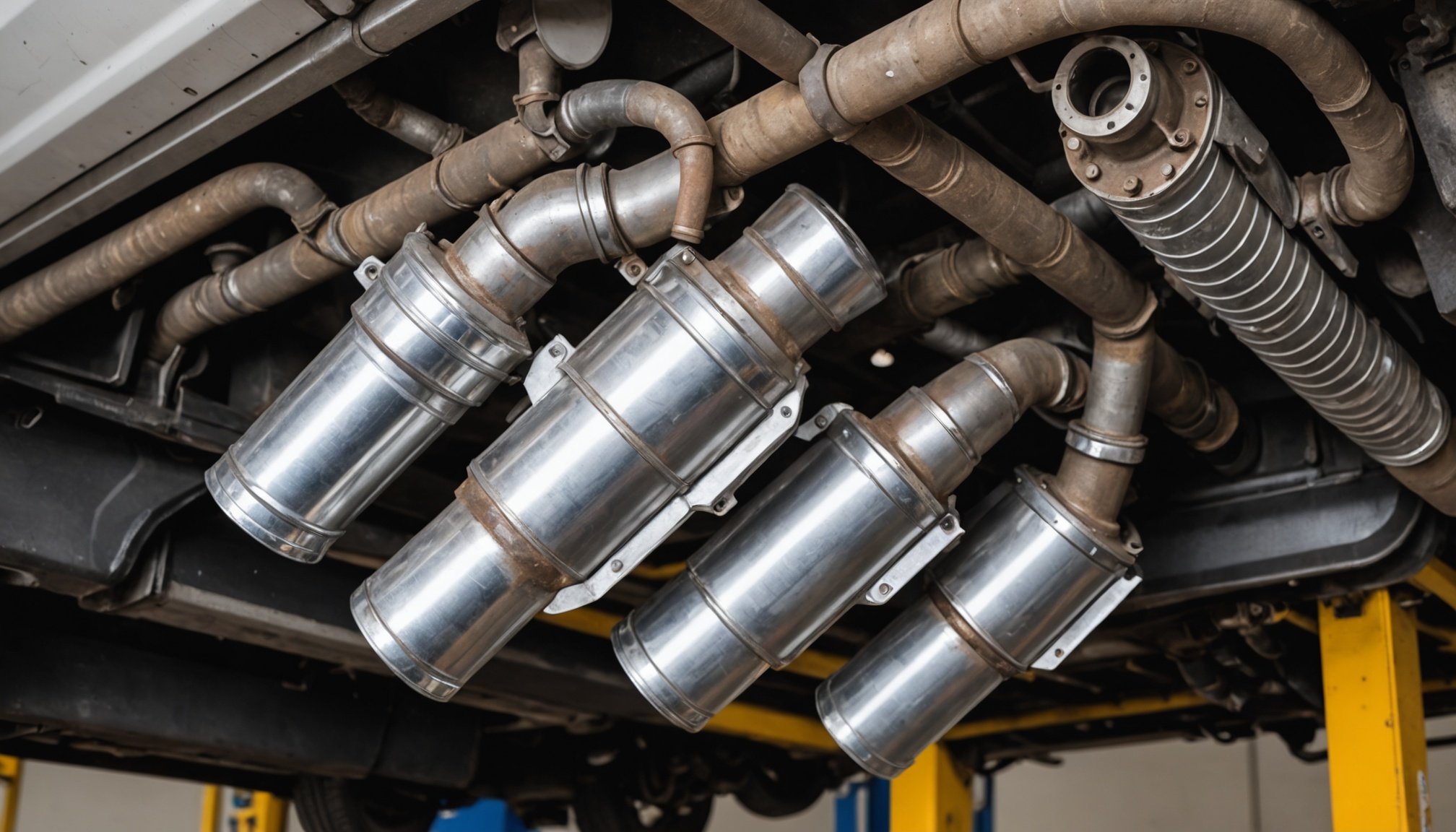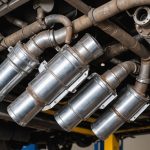Signs of Catalytic Converter Failure
Understanding the catalytic converter symptoms can be crucial for identifying potential issues early. One of the most obvious warning signs is unusual noises from the exhaust system. Sometimes, a failing catalytic converter may cause a rattling sound when the vehicle starts or idles. This might be due to loosened parts within the converter. A vibration from the exhaust is also a notable symptom and can signal an internal failure.
Moreover, decreased acceleration and overall vehicle performance issues are telltale signs. If your car struggles to pick up speed or feels sluggish, it might indicate a blockage in the catalytic converter impeding exhaust flow. This hindrance can strain the engine, reducing its efficiency and responsiveness.
Topic to read : Essential Guide to Properly Verify Your Off-Road Vehicle”s Rear Differential Lock Functionality
Finally, watch for engine warning lights on your dashboard. The onboard diagnostic system often detects issues such as increased emissions, illuminating the check engine light. Diagnostic trouble codes, which mechanics can read, could pinpoint the catalytic converter as the problem.
Recognizing these symptoms helps in addressing catalytic converter failure before it exacerbates other vehicle performance issues. Taking timely action ensures better engine health and smoother driving experience.
In the same genre : Essential Safety Guidelines for Installing Aftermarket Suspension Kits: Avoiding Common Pitfalls
Decreased Fuel Efficiency
A malfunctioning catalytic converter often results in poor gas mileage. This is primarily due to the device’s role in processing exhaust, which, when compromised, hinders optimal engine performance. An early sign might be a noticeable increase in fuel consumption without any additional driving.
Identifying a significant drop in fuel efficiency can be challenging without closely monitoring your vehicle’s performance. However, one should be attentive to more frequent visits to the pump or observing a tank that empties faster than usual.
Efficiency problems aren’t solely linked to catalytic converters, though. Poor maintenance practices, such as ignoring spark plug wear, failing to replace air filters, or using improper tire pressure, can collectively diminish a vehicle’s fuel economy. Additionally, heavy loads or aggressive driving patterns may contribute to decreased fuel economy.
If you suspect an issue with your catalytic converter, a professional diagnostics check is advisable. This helps pinpoint the exact cause of fuel inefficiency and prevents further unnecessary expenditure on fuel.
Maintaining your vehicle through regular checks and adhering to scheduled services can mitigate many fuel efficiency issues before they revert to costlier repairs or more significant concerns.
Emissions and Exhaust Issues
Understanding the signs of increased emissions and exhaust odors is crucial for environmental compliance and vehicle health. An emissions test failure often indicates underlying exhaust problems, which can notably include a failing catalytic converter.
A failing catalytic converter is problematic not only for your vehicle’s performance but it also has a substantial environmental impact. This critical component reduces harmful emissions, converting them into less harmful gases. When it starts to fail, you might notice increased levels of exhaust odor, dark smoke, or even a rattling noise.
During routine emissions tests, it’s essential to monitor various indicators. These include:
- Exhaust problems: Look for unusual smoke colour or increased volume, which can be signs of inefficiencies or blockages.
- Warning lights: Pay attention to the Check Engine Light, as this may illuminate if there’s a problem with the emissions system.
- Fuel efficiency: Notice any unexpected drops in fuel efficiency, as this may reflect problems with emissions controls.
Being vigilant about these signs can help ensure your vehicle remains eco-friendly, compliant with regulations, and free from exhaust issues. Addressing these early can prevent costly repairs and contribute positively to environmental preservation.
Diagnostic Tools and Warning Lights
Navigating the dashboard can be perplexing when those unfamiliar warning lights illuminate. Understanding these can save time and troubleshooting fees. The catalyst for many engine troubles often lies in the OBD-II codes, which are crucial in pinpointing issues within your car, namely the catalytic converter.
The OBD-II diagnostic system monitors vehicle performance and identifies malfunctions by emitting specific codes. A code related to the catalytic converter might suggest issues like inefficiency or malfunction, typically represented by a code like P0420. Recognising these codes enables car owners to address problems before they escalate, potentially dodging costly repairs.
The most common warning lights linked to catalytic converters are the “Check Engine” or “Service Engine Soon” indicators. These lights signal that the vehicle’s computer has detected a fault, often necessitating further inspection.
If these warning lights appear, it’s vital to promptly use a code reader to extract the OBD-II codes and determine the root of the issue. Addressing the problem early on can prevent damage and ensure the vehicle runs efficiently. Additionally, consulting a professional when uncertain about a specific code ensures the car remains in peak condition.
When to Consult a Mechanic
When it comes to vehicle care, understanding when to seek professional inspection can save both time and money. If unusual symptoms persist or worsen, consulting a mechanic should be your first step. Symptoms like unusual noises, persistent warning lights, or leaking fluids require timely mechanic diagnostics to pinpoint issues accurately. Ignoring these signs might lead to more significant problems down the line, increasing repair costs.
Adhering to a recommended schedule for vehicle inspections and maintenance is crucial. Routine automotive services, as suggested by the vehicle manufacturer, help in detecting potential issues early. For instance, regular oil changes and brake checks can prolong the life of your vehicle.
Timely intervention is critical to prevent further damage. Mechanical issues often start small but can escalate if left unattended. Professionals can identify underlying problems that aren’t always evident to the untrained eye. This is why regular professional inspections and diagnostics form the backbone of a well-maintained vehicle.
In summary, never underestimate the importance of consulting a professional when your vehicle behaves abnormally. Automotive services paired with routine checks ensure your car remains in optimal condition, safeguarding against unexpected failures and extending its lifespan.
Maintenance Tips for the Catalytic Converter
Ensuring the health of your catalytic converter is crucial for vehicle performance and longevity. Routine practices such as preventative maintenance play a significant role in its upkeep. Regular inspections should involve checking the entire exhaust system for leaks or damage, ensuring that the catalytic converter functions efficiently.
Regular servicing of your vehicle is indispensable in preventing issues related to the catalytic converter. During these checks, mechanics can identify potential problems early, ensuring that components like oxygen sensors and the converter itself are functioning optimally. Vehicle care like this enhances the overall efficiency of your car and prolongs the utility of the catalytic converter, preventing costly repairs down the line.
Understanding that driving habits directly affect the lifespan of your catalytic converter can lead to better choices behind the wheel. Avoiding short trips where the engine doesn’t reach its optimal temperature can prevent the buildup of carbon deposits, which is detrimental to the converter. Moreover, driving smoothly and avoiding aggressive acceleration can reduce the strain on the exhaust system, thus supporting the catalytic converter’s longevity.
In summary, incorporating routine maintenance practices, committing to regular servicing, and adopting considerate driving habits are all essential strategies in preserving the function and extending the life of your catalytic converter. Understanding these factors contributes to an overall healthier vehicle and a smoother ride.
What to Expect During Replacement
Replacing a catalytic converter involves a methodical process that ensures your vehicle continues to meet emissions standards. Understanding each step equips you with the knowledge to manage service expectations effectively.
Replacement Process: The procedure begins with an assessment of the current converter, identifying wear or damage. Often, the vehicle is elevated for easier access, and the mechanic uses specialized tools to safely remove the faulty component. Subsequently, a new catalytic converter is installed, and connections are verified for leaks, ensuring optimal function.
Costs and Time: The costs can vary significantly depending on the vehicle make and model. Generally, expect to pay between $500 and $2,200. Labour costs contribute considerably to this price range. The replacement process usually takes 1 to 2 hours, but it might extend if additional repairs are needed or due to unexpected complications.
Post-Replacement Care: After installation, periodic monitoring is essential. Stay alert for unusual noises or reduced engine performance, indicating potential issues. It’s advisable to follow up with regular vehicle maintenance to preserve the catalytic converter’s longevity. Proper care ensures it serves efficiently over the years, saving on future costs and maintaining emission compliance.











